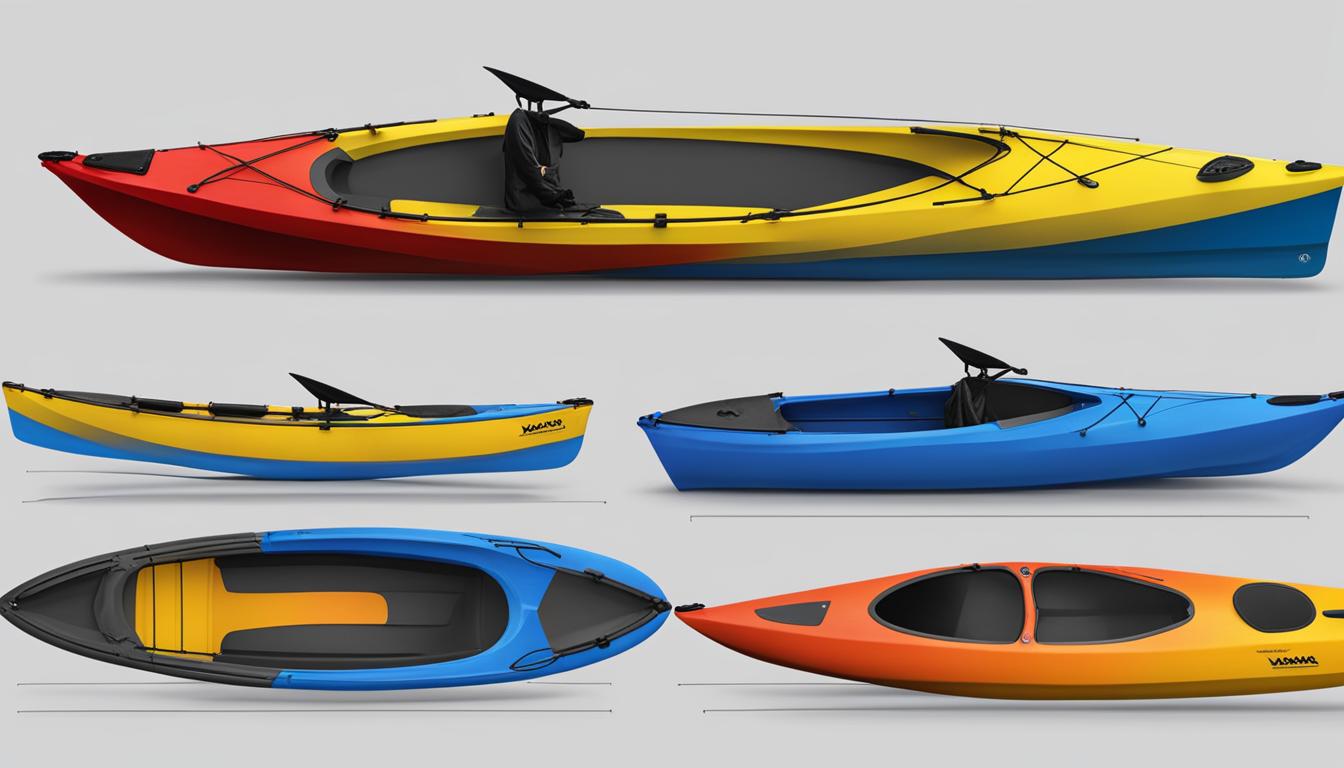The hull shape of a kayak plays a crucial role in determining its performance on the water. Different hull shapes offer varying levels of stability, speed, maneuverability, and tracking. Understanding the different types of kayak hull designs can help you choose the right kayak for your needs.
Key Takeaways:
- Choosing the right kayak hull shape is important for optimal stability and performance.
- Rounded hulls offer increased secondary stability, making them suitable for rough water conditions.
- Flat hulls provide excellent primary stability, making them ideal for beginners and calm water kayaking.
- Advanced hull designs, such as V-shaped or rounded hulls, offer better tracking, increased speed, and improved maneuverability.
- Customizing the hull shape of your kayak can enhance stability and control for specific activities like fishing or rough water kayaking.
Types of Kayak Hulls and Their Characteristics
When it comes to choosing a kayak, understanding the different types of hull designs and their characteristics is essential. Two common types of kayak hulls are rounded hulls and flat hulls, each offering distinct advantages for different paddlers and water conditions.
Rounded Hulls: Increased Stability and Rough Water Performance
Rounded hulls are known for their increased secondary stability, making them ideal for rough water conditions. These hulls have a curved shape that allows them to roll and respond to waves, providing excellent stability and control. With a rounded hull, you can confidently navigate through choppy waters and enjoy a smooth ride. However, rounded hulls sacrifice some primary stability, which may make them feel less stable to beginners in calm water.
Flat Hulls: Excellent Primary Stability for Beginners
On the other hand, flat hulls offer excellent primary stability, making them a popular choice for beginners and calm water kayaking. Flat hulls have a wider bottom surface that provides a solid and stable platform, allowing beginners to feel confident and balanced. These hulls are less responsive to waves and tend to track straighter, offering better stability in calm conditions.
Comparing Rounded Hulls and Flat Hulls
When choosing between rounded hulls and flat hulls, consider your skill level and intended use. Rounded hulls are favored by experienced paddlers who want increased stability and maneuverability in rough waters. Flat hulls, on the other hand, are ideal for beginners or those who prefer calm water kayaking. By understanding the characteristics of each hull type, you can select the kayak that best suits your needs and preferences.

| Hull Type | Primary Stability | Secondary Stability | Maneuverability | Recommended Use |
|---|---|---|---|---|
| Rounded Hull | Lower | Higher | Excellent | Rough water conditions |
| Flat Hull | Excellent | Lower | Good | Beginners, calm water kayaking |
Table: Comparison of Rounded Hulls and Flat Hulls
By comparing the primary stability, secondary stability, maneuverability, and recommended use of rounded hulls and flat hulls, you can make an informed decision when selecting a kayak. Remember that personal preference and individual skill level also play a role in determining the best hull shape for you.
Advanced Hull Designs for Speed and Maneuverability
When it comes to advanced kayaking, speed and maneuverability are key factors for experienced paddlers. This is where specialized hull designs come into play. Designed to optimize performance on the water, these advanced hull shapes offer enhanced speed, efficiency, and agility.
One popular hull design for speed is the V-shaped hull. This design features a pointed bow and a narrow, tapered shape that reduces drag and allows the kayak to slice through the water with minimal resistance. The V-shaped hull also provides excellent tracking, making it easier to maintain a straight course even in challenging conditions.
For long-distance kayaking, efficient hull shapes are essential. These hull designs prioritize efficiency by reducing friction and maximizing glide. One example is the long, slender hull shape, which offers reduced drag and increased speed over longer distances. This type of hull is often used by kayakers who participate in endurance races or extended expeditions.
In competitive kayaking, streamlined hull designs are favored to gain a competitive edge. These hulls are specifically engineered to minimize turbulence and increase speed. One example is the rounded hull shape, which allows the kayak to smoothly transition from one stroke to the next, maintaining momentum and maximizing acceleration. This design also enhances the kayak’s maneuverability, essential for navigating tight turns and obstacles during races.
Advanced Hull Designs for Speed and Maneuverability
- V-shaped hull: Provides increased speed, excellent tracking, and reduced drag.
- Slender hull shape: Optimized for long-distance kayaking, offering enhanced efficiency and glide.
- Rounded hull shape: Favored in competitive kayaking for its streamlined design, maximizing speed and maneuverability.
“The advanced hull designs available today have revolutionized the sport of kayaking. These specialized hull shapes offer significant advantages for paddlers seeking speed, efficiency, and maneuverability on the water.” – Kayak Expert
By understanding and choosing the right advanced hull design for your specific needs, you can take your kayaking skills to the next level. Whether you’re looking to compete in races, embark on long-distance journeys, or simply enjoy the thrill of speed and agility, these advanced hull designs will help you achieve your goals.

Customizing Hull Shapes for Specific Activities
If you’re an avid kayaker, you know that different activities require different features in a kayak. Customizing the hull shape of your kayak can greatly enhance your performance and enjoyment on the water. Whether you’re tackling rough waters, fishing in calm lakes, or simply enjoying a leisurely paddle, understanding how hull shape impacts specific activities is essential.
For those seeking adventure in rough waters, choosing a kayak with a hull designed for stability is crucial. A wider, flatter hull provides greater stability, allowing you to navigate turbulent waters with confidence. Additionally, kayaks with a pronounced rocker – the curvature from bow to stern – are better equipped to handle waves and swells. Consider customizing your kayak with a hull shape that excels in challenging conditions to ensure a safe and thrilling experience.
If fishing is your passion, analyzing the hull design of your kayak becomes even more important. Stability and maneuverability are key factors for anglers, as you’ll often be casting lines and reeling in fish. Look for kayaks with a wider, more stable hull that allows you to stand up and move around without compromising balance. Additionally, a kayak with a flat hull and minimal rocker provides a steady platform for casting and reeling. Customize your kayak with a hull shape that caters to the specific demands of fishing, and you’ll be reeling in the big catches in no time.
Conclusion
The hull shape of a kayak plays a crucial role in determining its stability, speed, maneuverability, and tracking. By understanding the different types of hull shapes and their characteristics, you can make an informed decision when choosing a kayak that suits your needs.
For beginners and calm water kayaking, a kayak with a flat hull provides excellent primary stability, making it easier to balance and control. On the other hand, if you plan to venture into rough waters, a kayak with a rounded hull offers increased secondary stability, allowing you to handle waves and challenging conditions with more confidence.
Advanced kayakers seeking speed and maneuverability can opt for specialized hull designs such as V-shaped or rounded hulls. These designs enhance tracking, increase speed, and improve maneuverability, making them ideal for activities like long-distance kayaking and competitive racing.
In addition, customizing the hull shape of your kayak can further enhance its performance for specific activities. Whether you’re fishing or kayaking in calm waters, there are hull designs that can optimize stability, control, and maneuvering capabilities.
In conclusion, understanding how hull shape impacts kayak performance is essential for a successful paddling experience. Consider your skill level, intended use, and specific activity requirements when selecting a kayak. By doing so, you can ensure that your chosen kayak’s hull shape provides the stability and performance you need for an enjoyable time on the water.
FAQ
How does the hull shape of a kayak affect its stability?
The hull shape of a kayak greatly influences its stability. Different hull shapes offer varying levels of stability, with rounded hulls providing increased secondary stability and flat hulls offering excellent primary stability.
What type of hull shape is best for beginners?
Flat hulls are recommended for beginners as they provide excellent primary stability, making them easier to balance and maneuver, especially in calm water conditions.
What hull shape is ideal for advanced kayakers?
Advanced kayakers looking for speed and maneuverability often prefer hull shapes like V-shaped or rounded hulls. These designs offer better tracking, increased speed, and improved maneuverability, making them suitable for activities like long-distance kayaking and competitive kayaking.
Can I customize the hull shape of my kayak for specific activities?
Yes, depending on the specific activity, you can consider customizing the hull shape of your kayak. Different hull designs are better suited for various activities. For example, rough waters may require hull designs that provide increased stability and control, while fishing kayaks often have specific hull shapes that enhance stability and maneuverability. Calm water kayaking may benefit from different hull shapes for optimal performance.
How does hull shape impact performance in kayaking?
The hull shape of a kayak greatly influences its stability, speed, maneuverability, and tracking. By understanding the different hull shapes and their characteristics, you can make an informed decision when choosing a kayak that best suits your needs and preferences.





